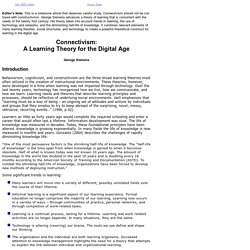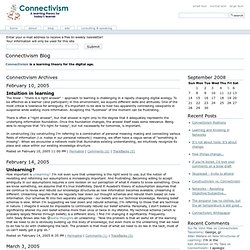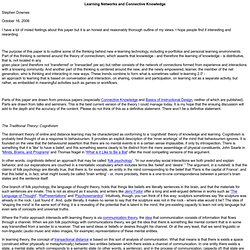

Connectivism, MOOCs and Innovation. - Learning, Teaching & Research on the Social Web. Rethinking Learning: The 21st Century Learner. 9 Characteristics Of 21st Century Learning. The label of “21st Century learning” is vague, and is an idea that we here at TeachThought like to take a swing at as often as possible, including: –weighing the magic of technology with its incredible cost and complexity –underscoring the potential for well thought-out instructional design –considering the considerable potential of social media platforms against its apparent divergence from academic learning Some educators seek out the ideal of a 21st century learning environment constantly, while others prefer that we lose the phrase altogether, insisting that learning hasn’t changed, and good learning looks the same whether it’s the 12th or 21st century.

Best Connected Teaching Tools. Advanced Databases and Search Engines. 5 Misconceptions About Networking. A good network keeps you informed.

Teaches you new things. Makes you more innovative. Gives you a sounding board to flesh out your ideas. Helps you get things done when you’re in a hurry. Learn to Love Networking. MyPLN. Jan05_01. Editor’s Note: This is a milestone article that deserves careful study.

MOOCs and More: Connectivism. Education-2020 - Connectivism. Connectivism: Learning theory of the future or vestige of the past? Social Development Theory (Vygotsky) Summary: Social Development Theory argues that social interaction precedes development; consciousness and cognition are the end product of socialization and social behavior.

Originator: Lev Vygotsky (1896-1934). Key terms: Zone of Proximal Development (ZPD), More Knowledgeable Other (MKO) Vygotsky’s Social Development Theory Vygotsky’s Social Development Theory is the work of Russian psychologist Lev Vygotsky (1896-1934), who lived during Russian Revolution. Vygotsky’s work was largely unkown to the West until it was published in 1962. About Stephen Downes. Learning, networks, knowledge, technology, community. Connected Educators. Adult Learner. 7.5. Internet history. John Bannister.pdf. Connectivism. Technological networks have transformed prominent businesses sectors: music, television, financial, manufacturing.

Social networks, driven by technological networks, have similarly transformed communication, news, and personal interactions. Education sits at the social/technological nexus of change – primed for dramatic transformative change. In recent posts, I’ve argued for needed systemic innovation. I’d like focus more specifically on how teaching is impacted by social and technological networks. What is the role of a teacher? A teacher/instructor/professor obviously plays numerous roles in a traditional classroom: role model, encourager, supporter, guide, synthesizer. This model works well when we can centralize both the content (curriculum) and the teacher. Course content is similarly fragmented.
What is the impact of conversation/content fragmentation? Traditional courses provide a coherent view of a subject. How can we achieve clear outcomes through distributed means? 1. Connectivism in the Classroom by Dawn Huskey on Prezi. Connectivism learning theory. Connectivism. What is connectivism?

[edit] Connectivism is a learning theory advocated by George Siemens and Stephen Downes, among others, which emphasises the importance and role of networks and connections between people (and things?) As preminent (central) to the learning process.TRY Connectivism glossary[edit] Welcome to CCK11 ~ CCK11. Connectivism: A Learning Theory for the Digital Age. Connectivism: A Learning Theory for the Digital Age December 12, 2004 George Siemens Update (April 5, 2005): I've added a website to explore this concept at www.connectivism.ca Introduction Behaviorism, cognitivism, and constructivism are the three broad learning theories most often utilized in the creation of instructional environments.

Learners as little as forty years ago would complete the required schooling and enter a career that would often last a lifetime. What Is Web 2.0. By Tim O'Reilly 09/30/2005 Oct. 2009: Tim O'Reilly and John Battelle answer the question of "What's next for Web 2.0? " in Web Squared: Web 2.0 Five Years On. The bursting of the dot-com bubble in the fall of 2001 marked a turning point for the web.
Many people concluded that the web was overhyped, when in fact bubbles and consequent shakeouts appear to be a common feature of all technological revolutions. Shakeouts typically mark the point at which an ascendant technology is ready to take its place at center stage. The concept of "Web 2.0" began with a conference brainstorming session between O'Reilly and MediaLive International. In the year and a half since, the term "Web 2.0" has clearly taken hold, with more than 9.5 million citations in Google. Connectivism Blog: Connectivism Archives. I enjoy instructing instructors.

Any long term change in our formal learning institutions will be bottom up - as educators change and experiment with new ways to maximize the learner's experience and value. Recently, I instructed a course on "testing, evaluation, and assessment". Some learners responded quite favorably to my approach, others felt I was downright cruel. The traditional view of education (teach and test) is strongly rooted in our schools/colleges. New methods of instructions are often seen with distrust. The frontier of education: Web 3D. A simulpost with TechLearningAs I read about the evolution of the Web, I just feel that many of the experts are missing it!

(Perhaps the 3D web is part of the "intelligent agent" idea, but I'm not so sure.) Yes, I think the semantic web is important (see the W3c specs) and inherently part of the future of the web, but I think there is one overarching evolution happening right now under our feet that is inexorably enmeshed with the semantic web. It is there amidst the video games and "fun things" that most educators refuse to recognize. Learning, networks, knowledge, technology, community. e4innovation.com. Networked Student.
Connectivism. Learning Networks and Connective Knowledge Stephen Downes October 16, 2006.

The Changing Nature of Knowledge. Vygotsky, ZPD, Scaffolding, Connectivism and Personal Learning Networks. An Introduction to Connective Knowledge. Revised and Updated (minor corrections and typos only) and placed in MS-Word Document form, November 27, 2007. Click here. The version that follows below is the original (uncorrected) version). Yet another article, describing new forms of knowledge as probablistic, has crossed my desk today, and consequently it seems appropriate at this time to type a few words on the nature of distributed knowledge. It should go without saying that these are my own thoughts, and this discussion should not therefore be considered an authoritative reference on the subject.